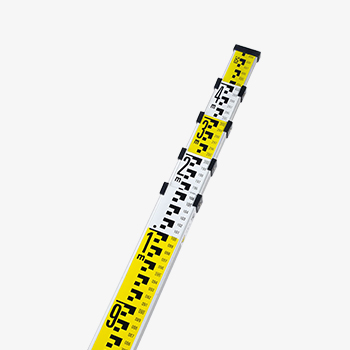The leveling rod is made of aluminum alloy and other light and high strength materials. It adopts the form of tower shrinkage, which is convenient to draw out when in use.

Double-sided stretch
- Sturdy thick aluminum, made of high quality aluminum.
- Stable ring, make the leveling rod more stable.
- Clear scale, able to read clearly.
Application
A levelling staff is a tool used in surveying to determine the elevation or height of points on the earth's surface relative to a reference point. Leveling rod is a fundamental tool in surveying and is used in a variety of applications, including: construction, woodworking, land surveying, environmental monitoring and so on.

| Model | SISCO-LS-3 |
| Material | aluminum alloy |
| Length | 3m |
| Face Width | 5 cm |
| Full Reduction Length | 118 cm |
| Durability | extra strong |
| Locking Button | metal enforced buttons |
Q1: What is leveling staff?
A1: A leveling staff, also known as a levelling rod or a surveying rod, is a long, graduated pole or staff used in land surveying to determine the difference in elevation between points. It typically consists of a series of uniformly spaced marks or graduations, which are read by the surveyor using a surveying instrument, such as a level or a theodolite.
Q2: How do you read a levelling staff?
A2: A staff reading consists of 4 digits. The first digit represents the whole number of meters, the second digit represents decimeters, and the third, and fourth digits represent millimeters.
Q3: What are the two methods of levelling?
A3: The important methods of levelling used while surveying are as follows : barometric levelling and trigonometric levelling.
Tips: How to use leveling staff?
A leveling staff is a measuring instrument used in surveying and construction to determine height differences and elevations between different points. Here's how to use it:
- Choose a suitable location. Choose a location that provides a clear line of sight to the other points you want to measure. Make sure the location is stable and level.
- Set up the leveling staff. Place the leveling staff at the point you want to measure the elevation.
- Position the level. Position the level so that it is level and stable. Use the leveling screws to adjust the level if necessary.
- Take the initial reading. Look through the level and take a reading of the height of the staff at its base.
- Move to the next location. Move the level to the next location you want to measure. The new location should be within sight of the previous location.
- Take a reading. Look through the level and take a reading of the height of the staff at its base at the new location.
Thank you for buying industrial test and measurement equipment on SISCO.com, all products sold by SISCO and the partner cover a 12 months warranty, effective from the date of receiving the products.
What is covered?
SISCO is responsible for providing free spare parts, and free technical support to assist the customer to repair the defective products until the problem is solved.
What is not covered?
- Product purchased from anyone other than a SISCO store or a SISCO authorized reseller.
- Expendable parts.
- Routine cleaning or normal cosmetic and mechanical wear.
- Damage from misuse, abuse or neglect.
- Damage from use of parts other than SISCO approved.
- Damage from use outside the product’s usage or storage parameters.
- Damage from use of parts not sold by SISCO.
- Damage from modification or incorporation into other products.
- Damage from repair or replacement of warranted parts by a service provider other than a SISCO authorized service provider.
- Damage caused by the application environment not meeting the product usage requirements and the failure to perform preventive maintenance.

